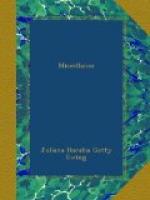Things “in miniature” have a natural charm for little people, and most of my young readers have probably been familiar with favourite copses, or miniature pine-forests. Perhaps some of them would like to know why these little woods never grow into big ones, and something also of the history and uses of those trees of which little woods are composed.
They are not made of dwarf trees. There are little woods, as well as big woods, of oak, elm, ash, pine, willow, birch, beech, and larch. In some cases the little woods are composed of the growth which shoots up when the principal trunk of the tree has been cut down, but they are generally little merely because they are young, and are cut down for use before they have time to grow into forest-trees. The object of this little paper is to give some account of their growth and uses. It will be convenient to take them alphabetically, by their English names.
The Ash (Fraxinus excelsior and other varieties) is a particularly graceful and fine tree at its full growth. It is a native of Great Britain, and of many other parts of the world. It is long lived. The most profitable age for felling it as a forest-tree is from eighty to a hundred years. The flower comes out before the leaves, which are late, like those of the oak. The bunches of seed-vessels, or “ash-keys,” as they are fancifully called, were pickled in salt and water and eaten in old times. The Greeks and Romans made their spears of ash-wood. The wood is not so durable as that of some other trees, but it is tough, and is thus employed for work subject to sudden strains. It is good for kitchen-tables, as it scours well and does not easily splinter.
In little woods, or ash-holts, or ash-coppices, the ash is very valuable. They are either cut over entirely at certain intervals, or divided into portions which are cut yearly in succession. At four or five years old the ash makes good walking-sticks, crates to pack glass and china in, hoops, basket handles, fences, and hurdles. Croquet-mallets are also made of ash. At twelve or fourteen it is strong enough for hop-poles. There are many old superstitions in connection with the ash, and there is a midland counties saying that if there are no keys on the ash, within a twelvemonth there will be no king.
There are several fine American varieties, and both in the States and in Canada the wood is used for purposes similar to ours.
The Alder (Alnus glutinosa, &c.) is never a very large tree. It is supposed to be in maturity when it is sixty years old. It will grow in wetter places than any other tree in Europe—even than the willow. Though the wood is soft, it is very durable in water. Virgil speaks of it as being used for boats. It is highly valued in Holland for piles, and it is said that the famous bridge of the Rialto at Venice is built on piles of alder-wood. Though invaluable for water-pipes, pump-barrels, foundations for bridges, &c., alder-wood is of little use on dry land unless it can be kept perfectly dry. Wooden vessels and sabots, however, are made of it.




